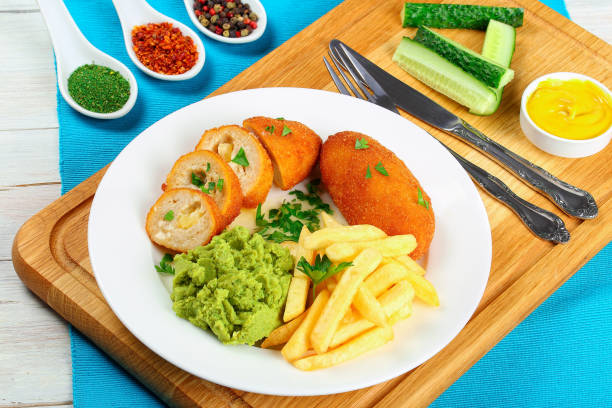
Mushy peas recipe
You can either love or dislike them; the traditional mushy peas pair well with British foods, as peanut butter is served with jelly. They are usually done with pub food like fish and chips or hot meat pie, and mushy peas fill the space traditionally reserved for coleslaw on the meal plate at American eateries. In Ireland, they are often served with roast lamb. Impostor mushy recipes make use of fresh and frozen peas. However, they’re not even as close to what you would find. However, marrowfat peas aren’t an essential ingredient in grocery stores within the U.S., but you can find them in specialty shops, online, and obviously, British supermarkets.
To cook traditional mushy peas, ensure to soak the dried peas for a long time (at least 8 hours unless labeled “no soak”), then simmer them and low. Marrowfat peas are mature green peas left to dry out in the fields. They are distinct from peas in the garden, which are still young, as they have a large amount of starch, which gives them a distinctive texture. Baking soda added to simmering peas causes them to expand and produce the desired mucus. Some people don’t like the outcome, but those who love it claim that the smooth melty peas taste delicious when eaten with freshly prepared hot chips or a meat pie right out of the oven, and best of all, with the delightful sprinkle in mint sauce.
Click Play to See This Traditional British Mushy Peas Recipe Come Together
“They’re very good! I made the marrowfat peas (bought online) as directed. I added salt and pepper, a teaspoon of sugar, and butter. The peas look a little drab in color at first but are bright vivid green once cooked. I also tried them with a little cream–they were rich and delicious both ways.” –Diana Rattray
Ingredients
8 ounces/225 grams dried marrowfat peas (available in British supermarkets, specialty stores, and online).
Two teaspoons baking soda.
1 to 1 1/2 teaspoons sugar, optional.
2 to 4 tablespoons heavy cream or milk, optional.
1 to 2 tablespoons butter or to taste, optional.
Steps to Make It
Collect the necessary ingredients.
Put the beans in a stockpot or bowl of a large size, as they require ample space to expand. Add the baking soda, and add 2 cups boiling water. Mix until baking soda is dissolved.
Allow the peas to soak for at least 12 hours.
The peas should be rinsed and drained in a colander, then transferred into a large pot.
Cover the peas in cool drinking water (about two cups) before bringing them up to boiling.
Reduce the heat, and let the peas simmer uncovered for about 30 minutes until they soften and then become soft.
Sprinkle the peas with salt and pepper according to your preference. You can add sugar if you like them a little more sweet, heavy cream or milk for more fluffiness, or butter for a savory taste. It is also possible to smash the mixture with a fork to create an even smoky texture or put it in a food processor if you prefer the consistency of a puree.
Serve the hot mushy peas with chips, fish, or a delicious meat pie. Enjoy.
Recipe Variation
Use freezing baby peas if you can’t find marrow-fat peas in your local market. Do not soak them and go directly to the stove top boil. Cook the peas per the instructions on the packaging, then smash them to create the traditional mushy peas texture. Add salt, pepper, and additional flavorings, if desired.
Although not traditional, A squeeze of lemon can enhance the taste of mushy peas. It is also possible to include chopped fresh herbs to enhance the flavor. Include about 1/4 cup of freshly crushed mint into the sweet peas. Add one tablespoon of lemon juice.
How to Store and Freeze Mushy Peas
Mushy peas cooked in the oven can be kept covered for some days when stored in the fridge. They can also be frozen inside an airtight container or a freezer bag made of plastic. Make a huge batch and divide it into portions for freezing.
What’s the Difference Between Marrowfat Peas and Fresh Garden Peas?
Fresh garden peas are harvested as they are still young. Peas that are marrowfat mature have been allowed to dry in the field before harvesting naturally. They give them a sweet texture and also the ability to turn soft.